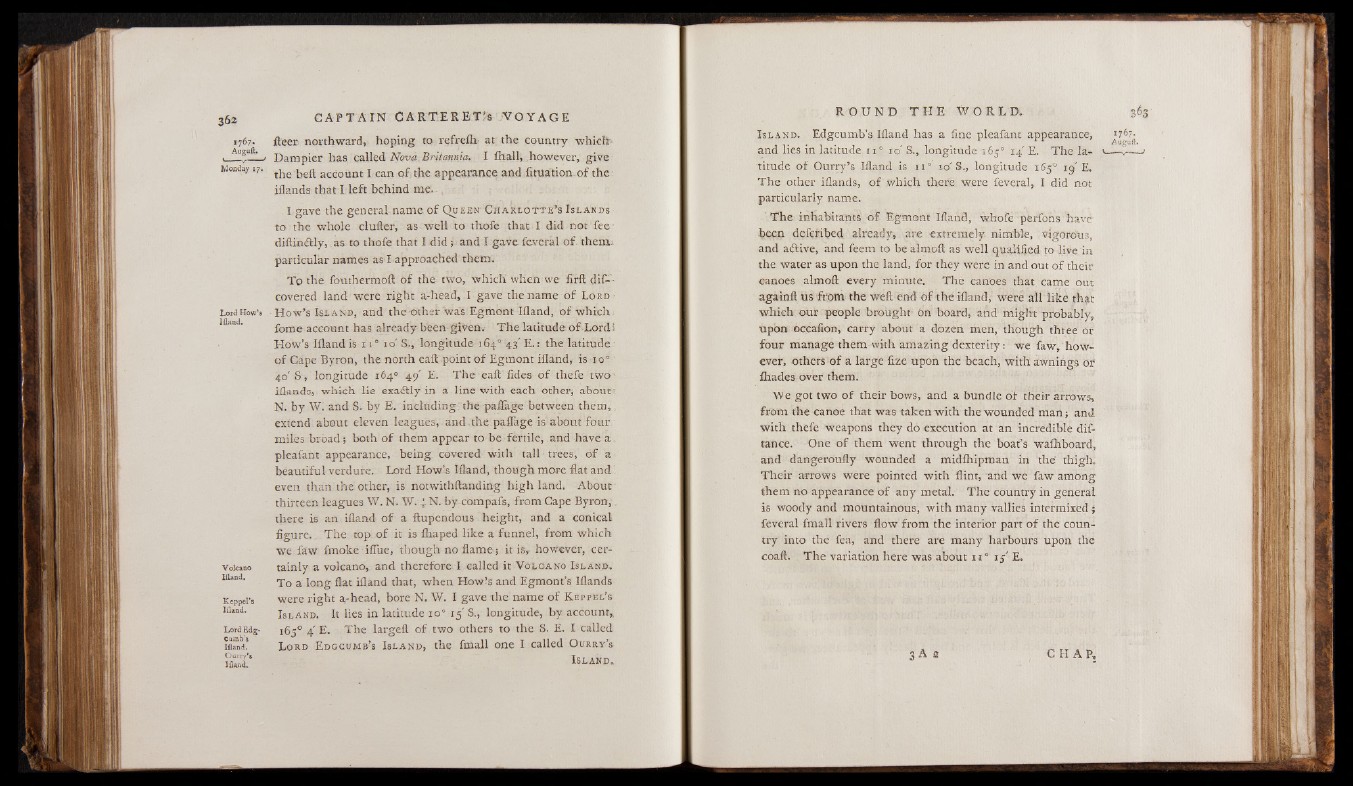
36a
1767. fleer northward, hoping to refrefh at; the country which-
■ A“gu_‘. j Dampier has called Nova. Britannia. I fhall, however, give
Monday 17. ^ account j can Gf the appearance and lituation o f the
iflands that ! left behind me.
Lord How’s
Ifland.
Volcano
Ifland.
Keppel’s
Ifland.
Lord Edg-
Camb’a '
Ifland.
Ifland.
I gave the generaLname o f Q u e e n C h a r l o t t e ’ s I s l a n d s
to the whole duller, as well to thofe that I did not fee-
diftindly,. as to thofe that I did and I gave feveral of them.-
particular names as I approached them.
To the fouthermoft o f the- two, which when we firft discovered
land were right a-head, I gave the name of Lord ■
How’s Is land, and the other was Egmont Ifland, o f which.
Lome account has already been given.- The latitude of Lord i
How’s Ifland i s n 6 io' S., longitude 164" 43' E.: the latitude -
o f Cape Byron, the north eafl; point o f Egmont ifland, is 10°
4 0 'S , longitude 164° 49' E. The eaflTides o f thefe two-
iflands, which lie exactly in a line with each other; about 1
N. by W. and S. by E. including the paflage between them,,
extend about eleven leagues, and the.paflage is about four
miles broad ; both of them appear to be fertile, and have a |
pleafant appearance, being covered with tall trees, of a
beautiful verdure. Lord How’s ifland, though more flat and
even than the other, is notwithstanding high land. About
thirteen leagues W. N. W. 4 N. by compafs, from Cape Byron,
there is an ifland o f a ftupendous height, and a conical
figure. The top of it is lhaped like a funnel, from which
we faw fmoke iflue, though no flame■ ; it is, however, certainly
a volcano, and therefore I called it V olcano Island.
To a long flat ifland that, when How’s and Egmont’s Iflands
were right a-head, bore N. W. I gave the name of K eppel’s
Island. It lies in latitude 10° 15' S., longitude, by account,.
165° 4' E. The largeft of two others to the S. E. I called
L ord Edgcumb’s Island, the fmall one I called Ourry’s
I s l a n d .
I s l a n d . Edgcumb’s Ifland has a fine pleafant appearance,
and lies in latitude 11° 10' S,, longitude 165° 14' E. The la- v_— „—
titude o f Ourry’s Ifland is 11° 10' S„ longitude 165'’ 19 'E.
The other iflands, of which there were feveral, I did not
particularly name.
The inhabitants of Egmont Ifland, whofe perfohs have
been defefibed. already» are extremely nimble, vigorous,
and aftive, and feem to be almoft as well qualified to live in
the water as upon the land, for they were in and out of their
canoes almoft every minute. The canoes that came out
againft us from the weft end of the ifland, were all like that
which our people brought on board, and might probably,
upon occafion, carry about a dozen men, though three or
four manage them with amazing dexterity: we faw, however,
others o f a large fize upon the beach, with awnings or
Ihades over them.
We got two of their bows, and a bundle o f their arrows,
from the canoe that was taken with the wounded man; and
with thefe weapons they do execution at an incredible dif-
tance. One o f them went through the boat’ s wafliboard,
and dangeroufly wounded a midfliipman in the' thigh.
Their arrows were pointed with flint, and we faw among
them no appearance o f any metal. The country in general
is woody and mountainous, with many vallies intermixed ;
feveral fmall rivers flow from the interior part o f the country
into the fea, and there are many harbours upon the
coaft. The variation here was about 11° 15' E.
3 A a C H A P .